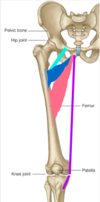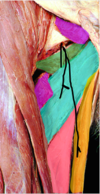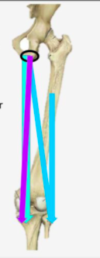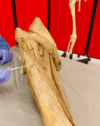The Thigh and Knee Flashcards
(247 cards)
Where is the lumbosarcal plexus located?
Abdomen and pelvis
What does the lumbosacral plexus innervate?
The lower limb

What spinal nerves form the lumbar plexus?
L1-L4
At each vertebral level, paired spinal nerves leave the spinal cord via the intervertebral foramina of the vertebral column. Each nerve then divides into anterior and posterior nerve fibres.
The lumbar plexus begins as the anterior fibres of the spinal nerves L1, L2, L3, and L4.

What are the 6 major branches of the lumbar plexus?
- Iliohypogastric
- Ilioinguinal
- Genitofemoral
- Lateral cutaneous nerve of the thigh
- Obturator nerve
- Femoral nerve

What spinal nerves form the lumbosacral trunk?
L4 and L5 - these then make connections with nerves from the sacral plexus. Together these form the lumbosacral plexus.
What is the major nerve formed by the lumbosacral trunk?
Sciatic nerve
What 2 parts does the sciatic nerve consist of?
Common fibular part and tibial part

What are the roots of the obturator nerve?
L2, L3, L4

What are the roots of the femoral nerve?
L2, L3, L4

What are the motor functions of the obturator nerve?
Innervates the muscles of the medial thigh:
- Obturator externus
- Adductor longus
- Adductor brevis
- Adductor magnus
- Gracilis
What are the sensory functions of the obturator nerve?
Innervates the skin over the medial thigh.
What are the motor functions of the femoral nerve?
Innervates the muscles of the anterior thigh – the illiopsoas, pectineus, sartorius and quadriceps femoris.
What are the sensory functions of the femoral nerve?
Innervates the skin on the anterior thigh and the medial leg
What forms the sacral plexus?
Formed by the anterior rami (divisions) of the sacral spinal nerves S1, S2, S3 and S4.
It also receives contributions from the lumbar spinal nerves L4 and L5 (lumbosarcal trunk)
How does the sacral plexus begin? How does this then form the lumbosacral trunk?
The sacral plexus begins as the anterior fibres of the spinal nerves S1, S2, S3, and S4.
They are joined by the 4th and 5th lumbar roots, which combine to form the lumbosacral trunk –> this descends into the pelvis to meet the sacral roots as they emerge from the spinal cord.

What are the 2 main destinations of the major nerves of the sacral plexus?
- Remain in pelvis to innervate structures here
- Leave the pelvis via the greater sciatic foramen
What is the 1st major branch of the sacral plexus?
Superior gluteal nerve

What are the spinal roots of the superior gluteal nerve?
L4, L5, S1
Motor function of superior gluteal nerve?
Innervates the gluteus medius, gluteus minimus and tensor fascia lata
Sensory function of the superior gluteal nerve?
None
Route of the superior gluteal nerve?
The superior gluteal nerve leaves the pelvis via the greater sciatic foramen, entering the gluteal region superiorly to the piriformis muscle. It is accompanied by the superior gluteal artery and vein for much of its course.
Route of the inferior gluteal nerve?
The inferior gluteal nerve leaves the pelvis via the greater sciatic foramen, entering the gluteal region inferiorly to the piriformis muscle.
It is accompanied by the inferior gluteal artery and vein for much of its course.
Roots of the inferior gluteal nerve?
L5, S1, S2

Motor and sensory function of the inferior gluteal nerve?
Motor Functions: Innervates gluteus maximus.
Sensory Functions: None.























































































































